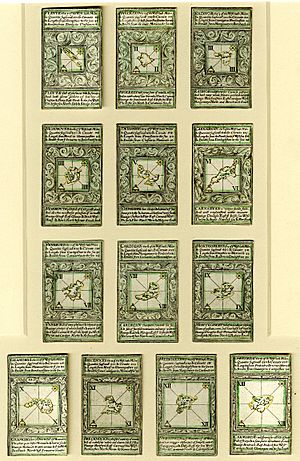Augustine Ryther facts for kids
Augustine Ryther (died 1593) was an English engraver and translator. An engraver is someone who carves designs onto metal plates, often for printing. A translator changes text from one language to another. Ryther is best known for helping to create maps of English counties and for his detailed charts of the Spanish Armada. He also made scientific tools.
Mapping England
Augustine Ryther worked with Christopher Saxton, a famous mapmaker, to engrave maps of English counties. These maps were published in 1579. Ryther's name appears on several of these maps, including those for County Durham and Westmorland (from 1576), and Gloucester and York (from 1577). He also engraved a large map of all of England in 1579.
In 1588, Ryther's name was listed alongside other well-known engravers like Jodocus Hondius. They all worked on sea charts for a book called The Mariner's Mirrour, which was written by Sir Anthony Ashley.
The Spanish Armada Charts
In 1590, Ryther published a translated book titled Expeditionis Hispaniorum in Angliam vera Descriptio. This book was about the Spanish Armada, a huge fleet of ships sent by Spain to invade England. Ryther translated the book from Italian.
The book included ten special charts. These charts showed the journey of the Spanish Armada through the English Channel. They also showed how the Armada was defeated and how it sailed around the British Isles. These important charts were originally drawn by Robert Adams, who was a surveyor for the queen.
How the Charts Were Used
Ryther's charts, or Adams's original drawings, were likely used to create famous tapestries (large woven pictures) about the Spanish Armada. These tapestries were made by Hendrik Cornelisz Vroom in Holland. They used to be displayed in the House of Lords in England. Later, smaller copies of Ryther's charts were published by John Pine.
Other Works
Augustine Ryther also worked with Thomas Hood, who was a mathematician.


